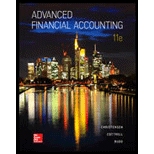
Advanced Financial Accounting
11th Edition
ISBN: 9780078025877
Author: Theodore E. Christensen, David M Cottrell, Cassy JH Budd Advanced Financial Accounting
Publisher: McGraw-Hill Education
expand_more
expand_more
format_list_bulleted
Question
Chapter 4, Problem 4.10.1E
To determine
Concept Introduction:
Equity Method of valuation of investment: In this method parent company value investment on the historical cost of the investment plus apportioned profit in the associate company less dividend paid by the associate company. Difference in the historical value and the amount paid for investment is debited to
To choose:Meaning of goodwill.
Expert Solution & Answer
Want to see the full answer?
Check out a sample textbook solution
Students have asked these similar questions
Recently, Abercrombie & Fitch has been implementing a turnaround strategy since its sales had been falling for the past few years (11% decrease in 2014, 8% in 2015, and just 3% in 2016.) One part of Abercrombie's new strategy has been to abandon its logo-adorned merchandise, replacing it with a subtler look. Abercrombie wrote down $20.6 million of inventory, including logo-adorned merchandise, during the year ending January 30, 2016. Some of this inventory dated back to late 2013. The write-down was net of the amount it would be able to recover selling the inventory at a discount. The write-down is significant; Abercrombie's reported net income after this write-down was $35.6 million. Interestingly, Abercrombie excluded the inventory write-down from its non-GAAP income measures presented to investors; GAAP earnings were also included in the same report. Question: What impact would the write-down of inventory have had on Abercrombie's assets, Liabilities, and Equity?
Need answer general Accounting
Provide correct answer of this question answer general Accounting
Chapter 4 Solutions
Advanced Financial Accounting
Ch. 4 - When is the carrying value of the investment...Ch. 4 - What is a differential? How is a differential...Ch. 4 - Prob. 4.3QCh. 4 - Prob. 4.4QCh. 4 - Prob. 4.5QCh. 4 - Prob. 4.6QCh. 4 - Prob. 4.7QCh. 4 - Prob. 4.8QCh. 4 - Prob. 4.9QCh. 4 - Prob. 4.10Q
Ch. 4 - Prob. 4.11QCh. 4 - What determines whether the balance assigned to...Ch. 4 - What does the termpushdown accountingmean?Ch. 4 - Under what conditions is push-down accounting...Ch. 4 - Prob. 4.15QCh. 4 - Reporting Significant Investments in Common Stock...Ch. 4 - Prob. 4.2CCh. 4 - Prob. 4.3CCh. 4 - Prob. 4.4CCh. 4 - Prob. 4.5CCh. 4 - Prob. 4.1ECh. 4 - Prob. 4.2ECh. 4 - Prob. 4.3ECh. 4 - Prob. 4.4ECh. 4 - Prob. 4.5ECh. 4 - Prob. 4.6ECh. 4 - Prob. 4.7ECh. 4 - Prob. 4.8ECh. 4 - Prob. 4.9ECh. 4 - Prob. 4.10.1ECh. 4 - Prob. 4.10.2ECh. 4 - Prob. 4.10.3ECh. 4 - Prob. 4.10.4ECh. 4 - Prob. 4.10.5ECh. 4 - Prob. 4.11.1ECh. 4 - Prob. 4.11.2ECh. 4 - Prob. 4.11.3ECh. 4 - Prob. 4.11.4ECh. 4 - Prob. 4.12ECh. 4 - Prob. 4.13ECh. 4 - Prob. 4.14ECh. 4 - Prob. 4.15ECh. 4 - Prob. 4.16ECh. 4 - Prob. 4.17ECh. 4 - Prob. 4.18.1ECh. 4 - Prob. 4.18.2ECh. 4 - Prob. 4.18.3ECh. 4 - Prob. 4.18.4ECh. 4 - Prob. 4.18.5ECh. 4 - Prob. 4.18.6ECh. 4 - Prob. 4.19ECh. 4 - Prob. 4.30PCh. 4 - Prob. 4.33PCh. 4 - Prob. 4.35PCh. 4 - Prob. 4.36PCh. 4 - Prob. 4.37AP
Knowledge Booster
Similar questions
arrow_back_ios
SEE MORE QUESTIONS
arrow_forward_ios
Recommended textbooks for you
 Auditing: A Risk Based-Approach (MindTap Course L...AccountingISBN:9781337619455Author:Karla M Johnstone, Audrey A. Gramling, Larry E. RittenbergPublisher:Cengage Learning
Auditing: A Risk Based-Approach (MindTap Course L...AccountingISBN:9781337619455Author:Karla M Johnstone, Audrey A. Gramling, Larry E. RittenbergPublisher:Cengage Learning Auditing: A Risk Based-Approach to Conducting a Q...AccountingISBN:9781305080577Author:Karla M Johnstone, Audrey A. Gramling, Larry E. RittenbergPublisher:South-Western College Pub
Auditing: A Risk Based-Approach to Conducting a Q...AccountingISBN:9781305080577Author:Karla M Johnstone, Audrey A. Gramling, Larry E. RittenbergPublisher:South-Western College Pub Financial Reporting, Financial Statement Analysis...FinanceISBN:9781285190907Author:James M. Wahlen, Stephen P. Baginski, Mark BradshawPublisher:Cengage Learning
Financial Reporting, Financial Statement Analysis...FinanceISBN:9781285190907Author:James M. Wahlen, Stephen P. Baginski, Mark BradshawPublisher:Cengage Learning Intermediate Accounting: Reporting And AnalysisAccountingISBN:9781337788281Author:James M. Wahlen, Jefferson P. Jones, Donald PagachPublisher:Cengage Learning
Intermediate Accounting: Reporting And AnalysisAccountingISBN:9781337788281Author:James M. Wahlen, Jefferson P. Jones, Donald PagachPublisher:Cengage Learning Cornerstones of Financial AccountingAccountingISBN:9781337690881Author:Jay Rich, Jeff JonesPublisher:Cengage Learning
Cornerstones of Financial AccountingAccountingISBN:9781337690881Author:Jay Rich, Jeff JonesPublisher:Cengage Learning

Auditing: A Risk Based-Approach (MindTap Course L...
Accounting
ISBN:9781337619455
Author:Karla M Johnstone, Audrey A. Gramling, Larry E. Rittenberg
Publisher:Cengage Learning

Auditing: A Risk Based-Approach to Conducting a Q...
Accounting
ISBN:9781305080577
Author:Karla M Johnstone, Audrey A. Gramling, Larry E. Rittenberg
Publisher:South-Western College Pub


Financial Reporting, Financial Statement Analysis...
Finance
ISBN:9781285190907
Author:James M. Wahlen, Stephen P. Baginski, Mark Bradshaw
Publisher:Cengage Learning

Intermediate Accounting: Reporting And Analysis
Accounting
ISBN:9781337788281
Author:James M. Wahlen, Jefferson P. Jones, Donald Pagach
Publisher:Cengage Learning

Cornerstones of Financial Accounting
Accounting
ISBN:9781337690881
Author:Jay Rich, Jeff Jones
Publisher:Cengage Learning